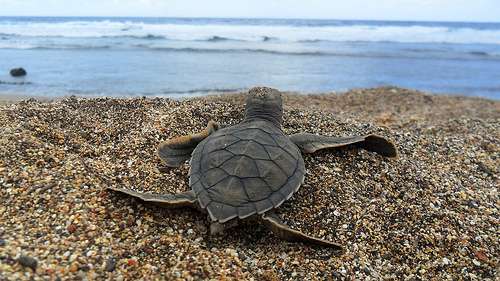Researchers use circulation models, genetics to track 'lost years' of turtles

When green turtles toddle out to the ocean after hatching from eggs at sandy beaches they more or less disappear from view and aren't seen again for several years until they show up as juveniles at coastal foraging areas.
Researchers have long puzzled over what happens to the turtles during these "lost years," as they were dubbed decades ago. Now a new study published in the Proceedings of the Royal Society B outlines where they likely would be based on ocean currents.
It is the first quantitative estimate of juvenile turtle distribution across an entire ocean basin and experts say it is significant because it gives researchers in North America, South America, Europe and Africa an idea of where hatchlings that emerge on beaches will go next, and where the juveniles foraging along the coastlines most likely came from.
"Hatchling sea turtles are too small for transmitters and electronic tags, and their mortality rate is sufficiently high to make it cost-prohibitive anyway," said Nathan F. Putman, a post-doctoral researcher at Oregon State University and lead author on the study. "Even if you could develop a perfect sensor, you would need tens of thousands of them because baby turtles get gobbled up at such a fast rate. So we decided to look at an indirect approach."
Putman and his colleague, Eugenia Naro-Maciel of City University of New York, used sophisticated ocean circulation models to trace the likely route of baby green turtles from known nesting sites once they entered the water. They also identified known locations of foraging sites where the turtles reappeared as juveniles, and went backwards – tracing where they most likely arrived via currents.
"This is not a definitive survey of where turtles go – it is more a simplification of reality – but it is a starting point and a big and comprehensive starting point at that," Putman pointed out. "Turtles have flippers and can swim, so they aren't necessarily beholden to the currents. But what this study provides is an indication of the oceanic environment that young turtles encounter, and how this environment likely influences turtle distributions.
"When we compared the predictions of population connectivity from our ocean current model and estimates from a genetic model, we found that they correlate pretty well," said Putman, a researcher in OSU's Department of Fisheries and Wildlife. "Each approach, individually, has limitations but when you put them together the degree of uncertainty is substantially reduced."
The researchers simulated the dispersal of turtles from each of 29 separate locations in the Atlantic and West Indian Ocean and identified "hot spots" throughout these basins where computer models suggest that virtual turtles would be densely aggregated. This includes portions of the southern Caribbean, the Sargasso Sea, and portions of the South Atlantic Ocean and the West Indian Ocean.
In contrast, they estimate that the fewest number of turtles would be located in the open ocean along the equator between South America and central Africa.
Based on the models, it appears that turtles from many populations would circumnavigate the Atlantic Ocean basin. "Backtracking" simulations revealed that numerous foraging grounds were predicted to have turtles arrive from the North Atlantic, South Atlantic and Southwest Indian oceans. Thus, a high degree of connectivity among populations appears likely based on circulation patterns at the ocean surface.
Putman said the next step in the research might be for turtle biologists throughout the Atlantic Ocean basin to "ground truth" the model by looking for young turtles in those hotspots. Knowing more about their early life history and migration routes could help in managing the population, he said.
"Perhaps the best part about this modeling is that it is a testable hypothesis," Putman said. "People studying turtles throughout the Atlantic basin will have predictions of turtle distributions based on solid oceanographic data to help interpret what they are observing.
"Finding these little turtles is like looking for the proverbial needle in the haystack," Putman added. "But at least we've helped researchers understand where that haystack most likely would be located."
Putman also has a study coming out in Biology Letters using similar methodology to predict ocean distribution patterns for the Kemp's ridley sea turtle.
More information: rspb.royalsocietypublishing.or … /1768/20131468.short
Journal information: Proceedings of the Royal Society B
Provided by Oregon State University




















